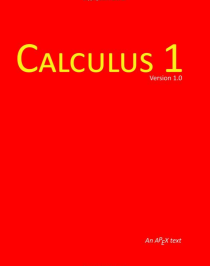
APEX Calculus 1

A college level treatment of standard Calculus topics beginning with limits and ending with iterated (multivariable) integration. The material is presented in a "traditional format," designed to make the transition from popular Calculus books (such as Stewart or Thomas/Finney) straightforward. This text is suitable for most "Calc I," "Calc II" and "Calc III" courses. This text is currently in use in MA 123, 124 and 215, Calculus and Analytic Geometry I, II & III at Virginia Military Institute.
The "Read" link above will download the full text. The "Order" link above is for the first of three volumes. Volume 2 and Volume 3 are also available for purchase.
License: Creative Commons Attribution Sharealike Noncommercial. This license is very open. It allows reuse, remixing, and distribution, but prohibits commercial use and requires any remixes use the same license as the original. This limits where the content can be remixed into, but on the other hand ensures that no-one can remix the content then put the remix under a more restrictive license. The non-commercial clause can make getting printed copies of remixes challenging depending upon how strictly the authors interpret the clause.
Formats:
- PDF. A Portable Document Format (PDF) file is can be opened using the free Acrobat Reader. It is not an editable format.
- TeX. A TeX file use the TeX or LaTeX typesetting engine. TeX software is available free for most platforms. It is an editable format
Openness Rating (0-4): 2
Openness Comments: NOTE: The license is actually CC-NC (without the ShareAlike). I haven't updated the catalog to include that license yet, since almost no one uses it. The non-commercial license restricts some use, and the authors require contact by email to secure copies of the source files.
- 1 Limits
- 1.1 An Introduction To Limits
- 1.2 Epsilon-Delta Definition of a Limit
- 1.3 Finding Limits Analytically
- 1.4 One Sided Limits
- 1.5 Continuity
- 1.6 Limits involving infinity
- 2 Derivatives
- 2.1 Instantaneous Rates of Change: The Derivative
- 2.2 Interpretations of the Derivative
- 2.3 Basic Differentiation Rules
- 2.4 The Product and Quotient Rules
- 2.5 The Chain Rule
- 2.6 Implicit Differentiation
- 2.7 Derivatives of Inverse Functions
- 3 The Graphical Behavior of Functions
- 3.1 Extreme Values
- 3.2 The Mean Value Theorem
- 3.3 Increasing and Decreasing Functions
- 3.4 Concavity and the Second Derivative
- 3.5 Curve Sketching
- 4 Applications of the Derivative
- 4.1 Newton’s Method
- 4.2 Related Rates
- 4.3 Optimization
- 4.4 Differentials
- 5 Integration
- 5.1 Antiderivatives and Indefinite Integration
- 5.2 The Definite Integral
- 5.3 Riemann Sums
- 5.4 The Fundamental Theorem of Calculus
- 5.5 Numerical Integration
- 6 Techniques of Antidifferentiation
- 6.1 Substitution
- 6.2 Integration by Parts
- 6.3 Trigonometric Integrals
- 6.4 Partial Fraction Decomposition
- 6.5 Hyperbolic Functions
- 6.6 L’Hôpital’s Rule
- 6.7 Improper Integration
- 7 Applications of Integration
- 7.1 Area Between Curves
- 7.2 Volume by Cross-Sectional Area; Disk and Washer Methods
- 7.3 The Shell Method
- 7.4 Arc Length and Surface Area
- 7.5 Work
- 7.6 Fluid Forces
- 8 Sequences and Series
- 8.1 Sequences
- 8.2 Infinite Series
- 8.3 Taylor Polynomials
- 9 Curves in the Plane
- 9.1 Conic Sections
- 9.2 Parametric Equations
- 9.3 Calculus and Parametric Equations
- 9.4 Introduction to Polar Coordinates
- 9.5 Calculus and Polar Functions
- 10 Vectors
- 10.1 Introduction to Cartesian Coordinates in Space
- 10.2 An Introduction to Vectors
- 10.3 The Dot Product
- 10.4 The Cross Product
- 10.5 Lines
- 10.6 Planes
- 11 Vector Valued Functions
- 11.1 Vector–Valued Functions
- 11.2 Calculus and Vector–Valued Functions
- 11.3 The Calculus of Motion
- 11.4 Unit Tangent and Normal Vectors
- 11.5 The Arc Length Parameter and Curvature
- 12 Functions of Several Variables
- 12.1 Introduction to Multivariable Functions
- 12.2 Limits and Continuity of Multivariable Functions
- 12.3 Partial Derivatives
- 12.4 Differentiability and the Total Differential
- 12.5 The Multivariable Chain Rule
- 12.6 Directional Derivatives
- 12.7 Tangent Lines, Normal Lines, and Tangent Planes
- 12.8 Extreme Values
- 13 Multiple Integration
- 13.1 Iterated Integrals and Area
- 13.2 Double Integration and Volume
- 13.3 Double Integration with Polar Coordinates
- 13.4 Center of Mass
- 13.5 Surface Area
- 13.6 Volume Between Surfaces and Triple Integration
Supplements: None